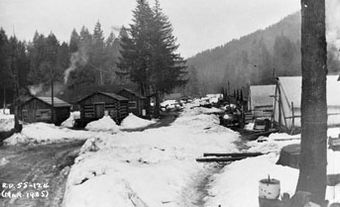In April 1935, about 1,500 residents of federal Unemployment Relief Camps in British Columbia went on strike. They travelled by train and truck to Vancouver to protest poor conditions in the Depression-era camps. After their months-long protest proved futile, they decided to take their fight to Ottawa. On 3 June, more than 1,000 strikers began travelling across the country, riding atop railcars. By the time they reached Regina, they were 2,000 strong. But they were stopped in Regina, where the strike leaders were arrested, resulting in the violent Regina Riot on 1 July 1935.

Striking Camp Workers
In early April 1935, during the Great Depression, a strike and protest by Unemployment Relief Camp workers was organized by the Workers’ Unity League (WUL). It was led by WUL officer Arthur "Slim" Evans. The League was affiliated with the international Communist movement. The protest was motivated by a desire for improved conditions and benefits in the camps, where workers were paid $0.20 per day for a 44-hour workweek. However, the federal government under Prime Minister R.B. Bennett was reluctant to provide work and wages programs.
In Vancouver, the strikers organized themselves into divisions. They undertook alliances with civic, labour, ethnic and political groups; held demonstrations; and spoke with government officials, among them British Columbia premier Dufferin T. Pattullo and Vancouver mayor Gerald McGeer. The two-month protest included the occupation of the Hudson’s Bay store and the city museum and library. A May Day parade also drew some 20,000 strikers and supporters to Stanley Park.
Negotiations with Ottawa
Local governments refused to take responsibility for the strikers’ welfare. The men themselves began to grow restless at the apparent failure of their protest. In response, Evans and his associates decided to take the movement to Ottawa. On 3 June, more than 1,000 strikers began the “On to Ottawa Trek.” They sought to inform the nation of their cause and to lay complaints before Parliament and Prime Minister R.B. Bennett.
The strikers peacefully commandeered freight trains. They made stops in Calgary, Medicine Hat, Swift Current and Moose Jaw, where more men joined their ranks. Their numbers had grown to around 2,000 by the time they reached Regina on 14 June In Regina, the railways, supported by an order from the prime minister, refused further access to their trains.
Negotiations with two federal Cabinet ministers took place on 17 June but went nowhere. Eight Trekkers were then dispatched to Ottawa to meet with Bennett. The remaining marchers waited at the Regina Exhibition Grounds. Food and shelter were supplied by townspeople and the Saskatchewan government, even though premier James Gardiner was displeased that the convoy of protestors had been stopped in his province’s capital.

Regina Riot
The talks in Ottawa quickly broke down. The delegation returned to Regina, having decided to disband the Trek. A rally was held at Regina’s Market Square on 1 July to secure last-minute assistance from the townspeople. Although the Trek was dispersing, Bennett had decided to arrest its leaders. That day, Regina constables and RCMP squads moved into a rallying crowd of some 300 people to arrest Evans and other speakers, thus provoking the Regina Riot.
The conflict raged back and forth on Regina streets. Trekkers assaulted police with rocks and clubs. Police fired guns into the crowd. The fracas ended by midnight, after the rioters had returned to the Exhibition Grounds. Two people, including one city constable, were killed; hundreds of people, including rioters, constables and citizens were injured; 130 rioters were arrested; and tens of thousands of dollars of damage was done to the city. Four days later, the Saskatchewan government helped the marchers on their way. Most of them returned on passenger trains to Vancouver.

Rioters converge on police officers and an injured man.
Significance
The repression of the Trekkers and Bennett’s antagonism towards Evans contributed to Bennett’s political decline. (See also Bennett’s New Deal.) The protest also increased the public profile of the Communist Party of Canada during the desperate times of the Great Depression. In 1997, the site of the Regina Riot was declared a National Historic Site by the federal government.
See also Vancouver Feature: Mayor McGeer Reads the Riot Act; Maclean’s Article: On to Ottawa Trek/Regina Riot.

 Share on Facebook
Share on Facebook Share on X
Share on X Share by Email
Share by Email Share on Google Classroom
Share on Google Classroom

